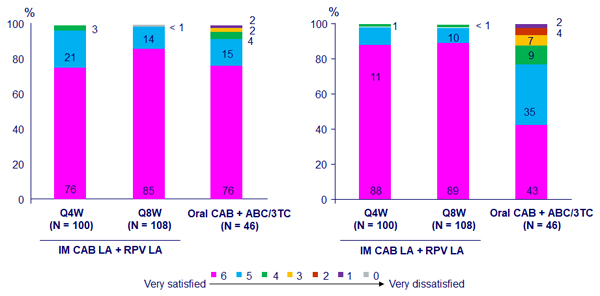Baseline characteristics (ITT-maintenance exposed)
and patient disposition

Primary endpoint: HIV RNA < 50 c/mL at W32
(snapshot analysis, ITT-ME)

- Non inferiority of the 2 IM regimens vs oral CAB
HIV RNA < 50 c/mL at W48 and W96 (snapshot analysis, ITT-ME)

- Non inferiority of the 2 IM regimens vs oral CAB, at W48 and W96
- Lower performance of Q4W (vs Q8W) at W96 due to more discontinuations for AE (9 vs 1)
- Protocol-defined virologic failure: 1 in oral arm (no resistance), 2 in Q8W arm (emergence of resistance at failure: K103N, E138G, K238T (NNRTI) and Q148R (INSTI) in 1, R269R/G in 1
Virologic non response and no data in window (snapshot analysis at W96)
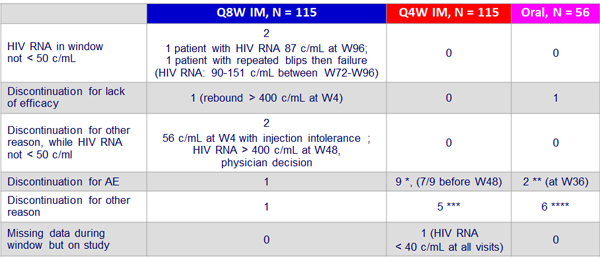
* Rash, N = 1, liver stopping criteria, N = 1, QT prolongation, N = 1, mesenteric vein thrombosis, N = 1, Churg-Strauss vasculitis, N = 1, epilepsy leading to death, N = 1, psychosis, N = 1, depression, N = 1, hepatitis C, N = 1
** Acute hepatitis C, N = 1, liver stopping criteria, N = 1
*** Withdrawal by subject, N = 3 ; protocol deviation, N = 2
**** Withdrawal by subject, N = 5 ; lost to follow-up, N = 1
Adverse events and laboratory abnormalities (ITT, maintenance period D0-W96), %
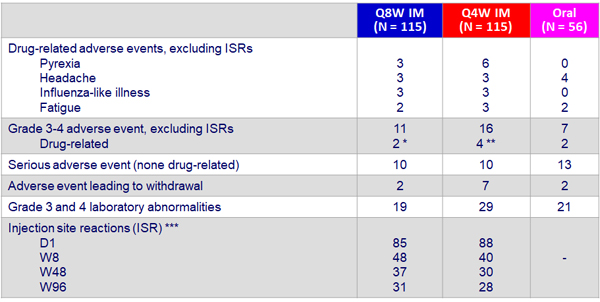
* Influenza-like illness, N = 1, chills and pain, N = 1
** Influenza-like illness, N = 1, rash, N = 1, depression, N = 1, QT prolongation, N = 1
*** ISR = pain (66%), nodules (8%), swelling( 6%), pruritus (6%), resolved < 7 days: 89%
Overall injection site reaction incidence,�by visit Day 1-Day 96 (% patients with ISR)
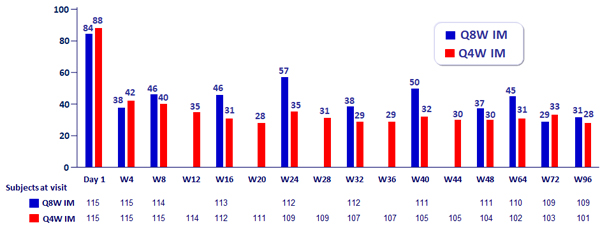
- 99% of ISRs were mild (84%) or moderate (15%)
- Median duration was 3.0 days in both groups, and 89% resolved within 7 days
- Most common ISR events : pain (66%), nodules (8%), swelling (6%) and pruritus (6%)
- The number of subjects reporting ISRs decreased over time, from 86% (D1) to 35% (W48) and 30% (W96)
- 2/230 subjects (< 1%) withdrew as a result of injection reactions (both in Q8W group)
Pharmacokinetics (mean + SD plasma concentration (mg/mL)
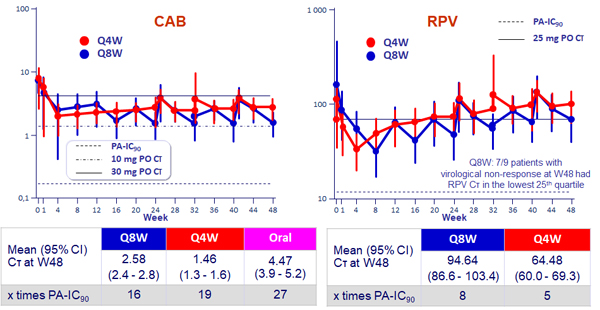
Cτ, trough concentration ; PA-IC90, protein binding-adjusted 90% inhibitory concentration
Patient reported-outcomes
(HIV Treatment satisfaction questionnaire, status version)
